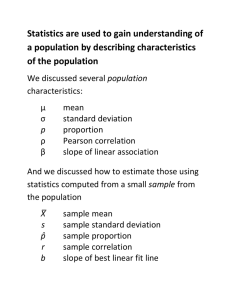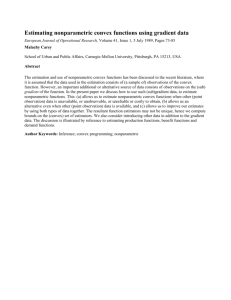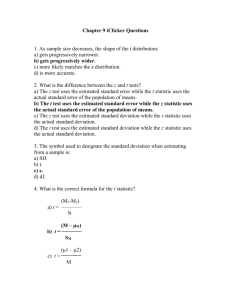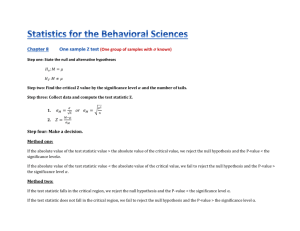Student Notes
advertisement
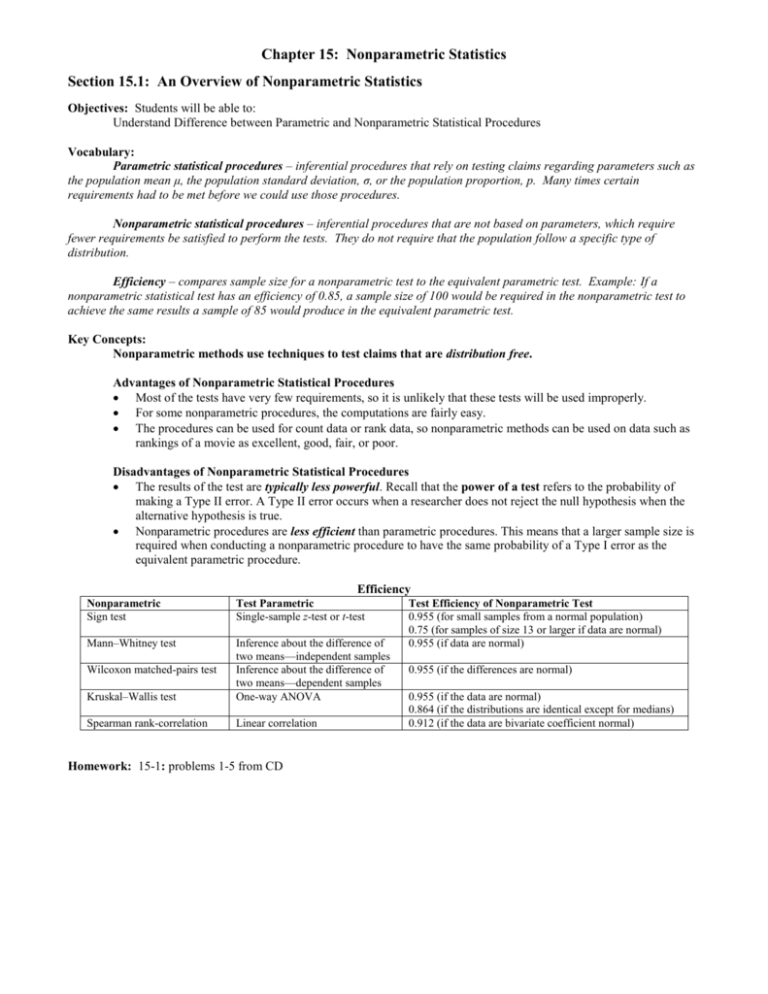
Chapter 15: Nonparametric Statistics Section 15.1: An Overview of Nonparametric Statistics Objectives: Students will be able to: Understand Difference between Parametric and Nonparametric Statistical Procedures Vocabulary: Parametric statistical procedures – inferential procedures that rely on testing claims regarding parameters such as the population mean μ, the population standard deviation, σ, or the population proportion, p. Many times certain requirements had to be met before we could use those procedures. Nonparametric statistical procedures – inferential procedures that are not based on parameters, which require fewer requirements be satisfied to perform the tests. They do not require that the population follow a specific type of distribution. Efficiency – compares sample size for a nonparametric test to the equivalent parametric test. Example: If a nonparametric statistical test has an efficiency of 0.85, a sample size of 100 would be required in the nonparametric test to achieve the same results a sample of 85 would produce in the equivalent parametric test. Key Concepts: Nonparametric methods use techniques to test claims that are distribution free. Advantages of Nonparametric Statistical Procedures Most of the tests have very few requirements, so it is unlikely that these tests will be used improperly. For some nonparametric procedures, the computations are fairly easy. The procedures can be used for count data or rank data, so nonparametric methods can be used on data such as rankings of a movie as excellent, good, fair, or poor. Disadvantages of Nonparametric Statistical Procedures The results of the test are typically less powerful. Recall that the power of a test refers to the probability of making a Type II error. A Type II error occurs when a researcher does not reject the null hypothesis when the alternative hypothesis is true. Nonparametric procedures are less efficient than parametric procedures. This means that a larger sample size is required when conducting a nonparametric procedure to have the same probability of a Type I error as the equivalent parametric procedure. Efficiency Nonparametric Sign test Test Parametric Single-sample z-test or t-test Mann–Whitney test Kruskal–Wallis test Inference about the difference of two means—independent samples Inference about the difference of two means—dependent samples One-way ANOVA Spearman rank-correlation Linear correlation Wilcoxon matched-pairs test Homework: 15-1: problems 1-5 from CD Test Efficiency of Nonparametric Test 0.955 (for small samples from a normal population) 0.75 (for samples of size 13 or larger if data are normal) 0.955 (if data are normal) 0.955 (if the differences are normal) 0.955 (if the data are normal) 0.864 (if the distributions are identical except for medians) 0.912 (if the data are bivariate coefficient normal) Chapter 15: Nonparametric Statistics Section 15.2: Runs Test for Randomness Objectives: Students will be able to: Perform a runs test for randomness Vocabulary: Runs test for randomness – used to test claims that data have been obtained or occur randomly Run – sequence of similar events, items, or symbols that is followed by an event, item, or symbol that is mutually exclusive from the first event, item, or symbol Length – number of events, items, or symbols in a run Key Concepts: Runs tests are used to test whether it is reasonable to conclude data occur randomly, not whether the data are collected randomly. Runs Test for Randomness Runs Test for Randomness Small-Sample Case: If n1 ≤20 and n2 ≤ 20, the test statistic in the runs test for randomness is r, the number of runs. Large-Sample Case: If n1 > 20 or n2 > 20 the test statistic in the runs test for randomness is 2n1n2 μr = -------- + 1 n r - μr z = ------where σr σr = 2n1n2 (2n1n2 – n) ----------------------n²(n – 1) Let n represent the sample size of which there are two mutually exclusive types. Let n1 represent the number of observations of the first type. Let n2 represent the number of observations of the second type. Let r represent the number of runs. Critical Values for a Runs Test for Randomness Small-Sample Case: Use Table IX for critical value at the level of significance α = 0.05 Large-Sample Case: Use Table IV, the standard normal table. Hypothesis Tests for Randomness Use Runs Test Hypothesis Tests for Randomness using Runs Test Step 0 Requirements: 1) the sample is a sequence of observations recorded in the order of their occurrence 2) the observations have two mutually exclusive categories. Step 1 Hypotheses: H0: The sequence of data is random. H1: The sequence of data is not random. Step 2 Level of Significance: (level of significance determines the critical value) Large-sample case: Determine a level of significance, based on the seriousness of making a Type I error. Small-sample case: we must use the level of significance, α = 0.05. Step 3 Compute Test Statistic: Small-Sample: r Step 4 Critical Value Comparison: Reject H0 if Small-Sample Case: r outside Critical interval Large-Sample Case: z0 < -zα/2 or z0 > zα/2 Step 5 Conclusion: Reject or Fail to Reject Large Sample: r - μr z0 = ------σr Chapter 15: Nonparametric Statistics Example 1: Example 2: Example 3: Homework: problems 1, 2, 5, 6, 7, 8, 15 from the CD Chapter 15: Nonparametric Statistics Section 15.3: Inferences about Measures of Central Tendency Objectives: Students will be able to: Conduct a one-sample sign test Vocabulary: One-sample sign test -- requires data converted to plus and minus signs to test a claim regarding the median. Key Concepts: One-Sample Sign Test 1) Change all data to + (above H0 value) or – (below H0 value) 2) Any values = to H0 value change to 0 Signs Test for Central Tendencies Test Statistic Small-Sample Case: If n ≤ 25, the test statistic in the signs test is k, defined as below. Left-Tailed Two-Tailed Right-Tailed H0: M = M0 H1: M < M0 H0: M = M0 H1: M ≠ M0 H0: M = M0 H1: M > M0 k = # of + signs k = smaller # of + or - signs k = # of - signs Large-Sample Case: If n > 25 the test statistic is (k + ½ ) – ½ n z0 = --------------------½ √n where k = is defined from above and n = number of + and – signs (zeros excluded) Critical Values for a Runs Test for Randomness Small-Sample Case: Use Table VII to find critical value for a one-sample sign test Large-Sample Case: Use Table IV, standard normal table (one-tailed -zα; two-tailed -zα/2). Hypothesis Tests for Central Tendency Using Signs Test Step 0: Convert all data to +, - or 0 (based on H0) Step 1 Hypotheses: Left-tailed H0: Median = M0 H1: Median < M0 Two-Tailed H0: Median = M0 H1: Median ≠ M0 Right-Tailed H0 : Median = M0 H1: Median > M0 Step 2 Level of Significance: (level of significance determines the critical value) Determine a level of significance, based on the seriousness of making a Type I error Small-sample case: Use Table X. Large-sample case: Use Table IV, standard normal (one-tailed -zα; two-tailed -z α/2). Step 3 Compute Test Statistic: Small-Sample: k (k + ½ ) – ½ n Large-Sample: z0 = --------------------½ √n Step 4 Critical Value Comparison: Reject H0 if Small-Sample Case: k ≤ critical value Large-Sample Case: z0 < -zα/2 (two tailed) or z0 < -zα (one-tailed) Step 5 Conclusion: Reject or Fail to Reject Homework: problems 5, 6, 10, 12 from the CD Chapter 15: Nonparametric Statistics Section 15.4: Inferences about the Differences between Two Medians: Dependent Samples Objectives: Students will be able to: Test a claim about the difference between the medians of two dependent samples Vocabulary: Wilcoxon Matched-Pairs Signed-Ranks Test -- a nonparametric procedure that is used to test the equality of two population medians by dependent sampling. Key Concepts: Requirements for testing a claim regarding the difference of two medians with dependent samples 1) the samples are dependent random samples 2) the distribution of the differences is symmetric (note: tests for this are beyond the scope of our book) Test Statistic for the Wilcoxon Matched-Pairs Signed-Ranks Test Small-Sample Case: (n ≤ 30) Left-Tailed Two-Tailed Right-Tailed H0: MD = 0 H1: MD < 0 H0: MD = 0 H1: MD ≠ 0 H0: MD= 0 H1: MD > 0 T = T+ T = smaller of T+ or |T-| T = |T-| Note: MD is the median of the differences of matched pairs. T+ is the sum of the ranks of the positive differences T- is the sum of the ranks of the negative differences Large-Sample Case: (n > 30) n (n + 1) T – -------------4 z0 = ----------------------------n (n + 1)(2n + 1) -----------------------24 where T is the test statistic from the small-sample case. Critical Value for Wilcoxon Matched-Pairs Signed-Ranks Test Small-Sample Case (n ≤ 30): Using α as the level of significance, the critical value is obtained from Table XI in Appendix A. Left-Tailed Two-Tailed Right-Tailed -Tα -Tα/2 -Tα Large-Sample Case (n > 30): Using α as the level of significance, the critical value is obtained from Table IV in Appendix A. The critical value is always in the left tail of the standard normal distribution. Left-Tailed Two-Tailed Right-Tailed -zα -zα/2 -zα Chapter 15: Nonparametric Statistics Hypothesis Tests Using Wilcoxon Test Step 0: Compute the differences in the matched-pairs observations. Rank the absolute value of all sample differences from smallest to largest after discarding those differences that equal 0. Handle ties by finding the mean of the ranks for tied values. Assign negative values to the ranks where the differences are negative and positive values to the ranks where the differences are positive. Step 1 Hypotheses: Left-Tailed Two-Tailed Right-Tailed H0: MD = 0 H1: MD < 0 H0: MD = 0 H1: MD ≠ 0 H0: MD= 0 H1: MD > 0 Step 2 Box Plot: Draw a boxplot of the differences to compare the sample data from the two populations. This helps to visualize the difference in the medians. Step 3 Level of Significance: (level of significance determines the critical value) Determine a level of significance, based on the seriousness of making a Type I error Small-sample case: Use Table XI. Large-sample case: Use Table IV. Step 4 Compute Test Statistic: Step 5 Critical Value Comparison: Reject H0 if test statistic < critical value Step 6 Conclusion: Reject or Fail to Reject Homework: problems 2, 4, 5, 8, 9, 15 from the CD Chapter 15: Nonparametric Statistics Section 15.5: Inferences about the Differences between Two Medians: Independent Samples Objectives: Students will be able to: Test a claim about the difference between the medians of two independent samples Vocabulary: Mann–Whitney Test -- nonparametric procedure used to test the equality of two population medians from independent samples. Key Concepts: Test Statistic for the Mann–Whitney Test The test statistic will depend on the size of the samples from each population. Let n1 represent the sample size for population X and represent the n2 sample size for population Y. Small-Sample Case: (n1 ≤ 20 and n2 ≤ 20 ) If S is the sum of the ranks corresponding to the sample from population X, then the test statistic, T, is given by n1 (n1 - 1) T = S – -------------2 Note: The value of S is always obtained by summing the ranks of the sample data that correspond to Mx , the median of population X, in the hypothesis. Large-Sample Case: (n1 > 20 or n2 > 20 ) From the Central Limit Theorem, the test statistic is given by n1 n2 T – ---------2 z0 = ----------------------------n1n2 (n1 + n2 + 1) -----------------------12 where T is the test statistic from the small-sample case. Critical Value for Mann–Whitney Test Small-Sample Case: (n1 ≤ 20 and n2 ≤ 20 ) Using α as the level of significance, the critical value is obtained from Table XII in Appendix A. Left-Tailed wα Two-Tailed Right-Tailed wα/2 w1-α = n1n2 - wα w1- α/2 = n1n2 - wα/2 Large-Sample Case: (n1 > 20 or n2 > 20 ) Using α as the level of significance, the critical value is obtained from Table IV in Appendix A. The critical value is always in the left tail of the standard normal distribution. Left-Tailed Two-Tailed Right-Tailed -zα zα/2 -zα/2 Zα Chapter 15: Nonparametric Statistics Hypothesis Tests Using Mann–Whitney Test Step 0 Requirements: 1. the samples are independent random samples and 2. the shape of the distributions are the same (assume to met in our problems) Step 1 Box Plots: Draw a side-by-side boxplot to compare the sample data from the two populations. This helps to visualize the difference in the medians. Step 2 Hypotheses: Left-Tailed Two-Tailed Right-Tailed H0: Mx = My H1: Mx < My H0: Mx = My H1: Mx ≠ My H0: Mx= My H1: Mx > My Step 3 Ranks: Rank all sample observations from smallest to largest. Handle ties by finding the mean of the ranks for tied values. Find the sum of the ranks for the sample from population X. Step 4 Level of Significance: (level of significance determines the critical value) Determine a level of significance, based on the seriousness of making a Type I error Small-sample case: Use Table XII. Large-sample case: Use Table IV. Step 5 Compute Test Statistic: Step 6 Critical Value Comparison: Reject H0 if test statistic more extreme (further away from 0) than the critical value Step 7 Conclusion: Reject or Fail to Reject Homework: problems 4, 5, 9, 10, 12 from the CD Chapter 15: Nonparametric Statistics Section 15.6: Spearman’s Rank-Correlation Test Objectives: Students will be able to: Perform Spearman’s rank-correlation test Vocabulary: Rank-correlation test -- nonparametric procedure used to test claims regarding association between two variables. Spearman’s rank-correlation coefficient -- test statistic, rs Key Concepts: Hypothesis Test with Spearman’s Rank-Correlation Left-Tailed Two-Tailed Right-Tailed H0 : X and Y are not associated H0 : X and Y are not associated H0 : X and Y are not associated H1 : X and Y are negatively associated H1 : X and Y are associated H1 : X and Y are negatively associated Test Statistic for Spearman’s Rank-Correlation Test The test statistic will depend on the size of the sample, n, and on the sum of the squared differences (di²). 6 Σ di ² rs = 1 – -------------n(n²- 1) where di = the difference in the ranks of the two observations (Y i – Xi) in the ith ordered pair. Spearman’s rank-correlation rs, is our test statistic Critical Value forcoefficient, Spearman’s Rank-Correlation Test Using α as the level of significance, the critical value(s) is (are) obtained from Table XIII in Appendix A. For a two-tailed test, be sure to divide the level of significance, α, by 2. Left-Tailed Two-Tailed Right-Tailed α α/2 α Hypothesis Tests Using Spearman’s Rank-Correlation Test Step 0 Requirements: 1. the data are a random sample of n ordered pairs 2. each pair of observations is two measurements taken on the same individual. Step 1 Hypotheses: Left-Tailed Two-Tailed Right-Tailed H0 : X and Y are not associated H0 : X and Y are not associated H0 : X and Y are not associated H1 : X and Y - negatively associated H1 : X and Y - associated H1 : X and Y - negatively associated Step 2 Ranks: Rank the X-values, and rank the Y-values. Compute the differences between ranks and then square these differences. Compute the sum of the squared differences. Step 3 Level of Significance: (level of significance determines the critical value) Choose a level of significance, based on the seriousness of making a Type I error. The level of significance is used to determine the critical value. The critical value is found in Table XIII. Step 4 Compute Test Statistic: 6 Σ di ² rs = 1 – -------------n(n²- 1) Step 6 Critical Value Comparison: Positively Associated Two-Tailed Negatively Associated Reject H0 if rs is greater than the critical value in Table XIII. Reject H0 if rs is less than the negative of the critical value or rs is greater than the critical value in Table XIII. Reject H0 if rs is less than the negative of the critical value in Table XIII. Homework: problems 3, 6, 7, 10 from the CD Chapter 15: Nonparametric Statistics Section 15.7: Kruskal-Wallis Test Objectives: Students will be able to: Test a claim using the Kruskal–Wallis test Vocabulary: Kruskal–Wallis Test -- nonparametric procedure used to test the claim that k (3 or more) independent samples come from populations with the same distribution. Key Concepts: The Kruskal–Wallis test is always a right-tailed test Test Statistic for Kruskal–Wallis Test The test statistic for the Kruskal–Wallis test is 12 1 ni (N + 1) ² H = -------------- --- Ri - -----------N(N + 1) ni 2 Σ A computational formula for the test statistic is 12 R²1 R²2 R²k H = ------------- ----- + ----- + … + ------- - 3(N + 1) N(N + 1) n1 n2 nk where Ri is the sum of the ranks of the ith sample R²1 is the sum of the ranks squared for the first sample R²2 is the sum of the ranks squared for the second sample, and so on n1 is the number of observations in the first sample n2 is the number of observations in the second sample, and so on N is the total number of observations (N = n 1 + n2 + … + nk) k is the number of populations being compared. Critical Value for Kruskal–Wallis Test Small-Sample Case When three populations are being compared and when the sample size from each population is 5 or less, the critical value is obtained from Table XIV in Appendix A. Large-Sample Case When four or more populations are being compared or the sample size from one population is more than 5, the critical value is χ²α with k – 1 degrees of freedom, where k is the number of populations and α is the level of significance. Chapter 15: Nonparametric Statistics Hypothesis Tests Using Kruskal–Wallis Test Step 0 Requirements: 1. The samples are independent random samples. 2. The data can be ranked. Step 1 Box Plots: Draw side-by-side boxplots to compare the sample data from the populations. Doing so helps to visualize the differences, if any, between the medians. Step 2 Hypotheses: (claim is made regarding the distribution of three or more populations) H0: the distributions of the populations are the same H1: the distributions of the populations are not the same Step 3 Ranks: Rank all sample observations from smallest to largest. Handle ties by finding the mean of the ranks for tied values. Find the sum of the ranks for each sample. Step 4 Level of Significance: (level of significance determines the critical value) The critical value is found from Table XIV for small samples. The critical value is χ²α with k – 1 degrees of freedom (found in Table VI) for large samples. Step 5 Compute Test Statistic: 12 R²1 R²2 R²k H = ------------- ----- + ----- + … + ------- - 3(N + 1) N(N + 1) n1 n2 nk Step 6 Critical Value Comparison: We reject the null hypothesis if the test statistic is greate r than the critical value. Homework: problems 3, 5, 7, 10 from the CD Chapter 15: Nonparametric Statistics Chapter 15: Review Objectives: Students will be able to: Summarize the chapter Define the vocabulary used Complete all objectives Successfully answer any of the review exercises Vocabulary: None new Key Concepts: Nonparametric Test Runs Test (Section 15.2) Sign Test (Section 15.3) Wilcoxon Matched–Pairs Signed-Ranks Test (Section 15.4) Mann–Whitney Test (Section 15.5) Spearman RankCorrelation Coefficient (Section 15.6) Kruskal–Wallis Test Section (15.7) Parametric Test No equivalent procedure Purpose To test for randomness z-test or-t test (Sections 10.2 and 10.3) Test for the difference of means of dependent samples (Section 11.1) Test for linear relation (Section 14.1) To test a claim regarding a measure of central tendency To test a claim regarding the difference between two measures of central tendency when the sampling is dependent To test a claim regarding the difference between two measures of central tendency when the sampling is independent To test whether two variables are associated One-way analysis of variance (Section 13.1) To test whether three or more populations come from the same distribution Test for the difference of means of independent samples (Section 11.2) Homework: problems 2, 4, 5, 8, 9, 12 from the CD


